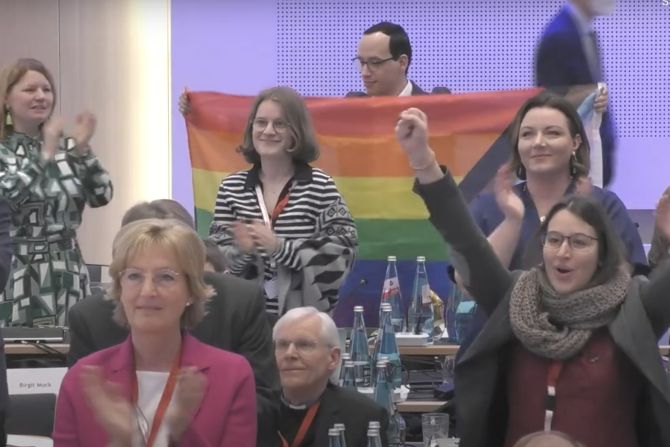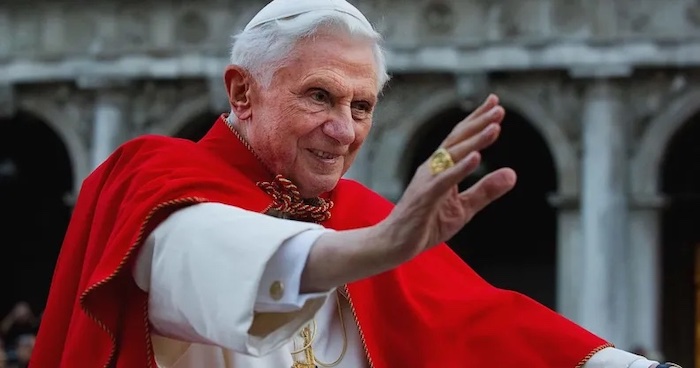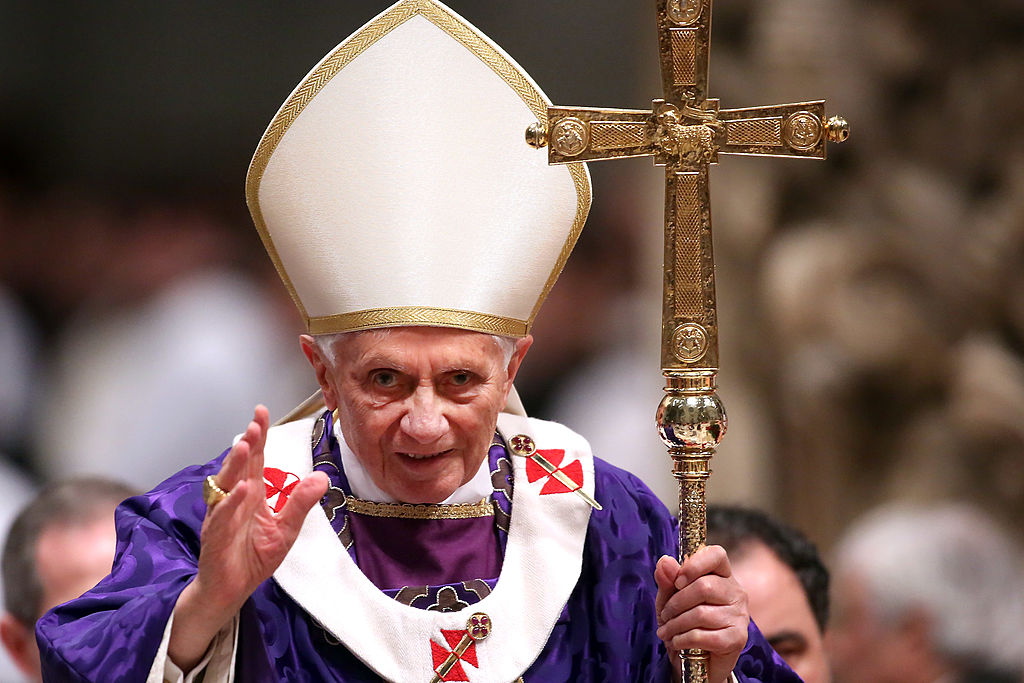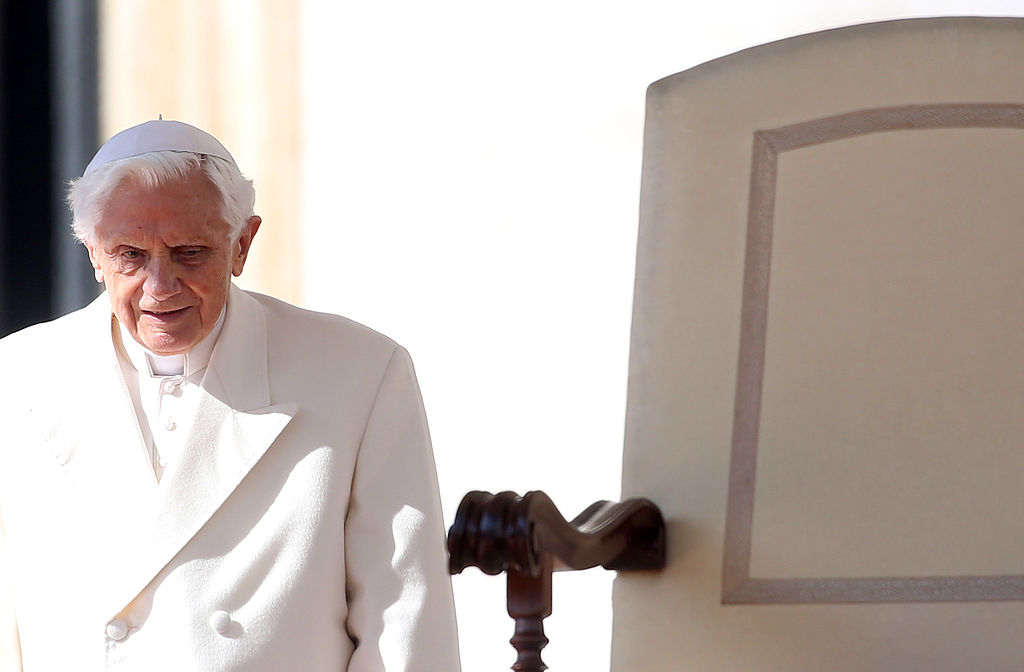— Can Womenpriests Save the Catholic Church?

By Fran Quigley
Every Sunday, 17,000 Roman Catholic parishes in the United States hold Mass. For the most part, the service in Brownsburg, Indiana, looks and sounds like the rest.
There are songs and Scripture readings. The white-robed priest delivers the homily. The Eucharistic Prayer features the consecration of the bread and wine on the altar, transforming them into what more than one billion Catholics worldwide believe is the flesh and blood of Jesus. Then all solemnly consume the bread and wine as the sacrament of Holy Communion.
But this Mass does have distinguishing features. The creed includes an invocation not just of God and Jesus but also “the Holy Spirit, the breath of Wisdom Sophia, who energizes and guides us in building caring communities and in challenging oppression, exploitation, and injustices.” The Lord’s Prayer begins here with the words, “Our Mother-Father God, who is in heaven . . .”
And the priest is Angela Nevitt Meyer, newly ordained and the 42-year-old mother of two children. For her first official Mass as a priest, both of her kids are in attendance, along with her husband Jarrett. He is the one playing the keyboard.
In return for daring to perform the Mass, Meyer and 250 others across the world who call themselves Roman Catholic womenpriests have been automatically excommunicated by Vatican decree. (The combination of women and priests into one name derives from the German word priesterin, used in the early stages of the European movement of ordained women.) The men controlling the 2,000-plus-year-old institution say these women are attacking the Church. Meyer and the womenpriests say they are saving it.
There is evidence that their movement is gaining momentum. More than half of U.S. states have at least one womanpriest-led congregation. Many, like Meyer’s Indiana congregation, began as home churches but soon outgrew the space. Several womenpriests were favorably featured in a lengthy June 2021 New Yorker magazine profile, others in a recent BBC documentary. The Women’s Ordination Conference, which advocates for Church reform, finds hope in ongoing Church discussions to open the diaconate to women, and multiple German bishops have signaled that they are open to adding women to the priesthood. Catholic catechism features the concept of sensus fidelum, a consensus among believers on matters of faith. Consensus on women priests is not yet reached, but a trend can be observed: a Pew Research Center poll showed 59 percent of U.S. Catholics support women’s ordination as priests. Many Catholics are excited that the ongoing global Catholic synod process has yielded an official Vatican synopsis of listening sessions that acknowledges that many Catholics call for women’s ordination, an admission that some ordination advocates call a “small revolution.”
THERE ARE STRONG scriptural and historical arguments for women assuming church leadership roles. The books of the New Testament show Jesus regularly bucking the patriarchy of the day to embrace women as central to his community and ministry. The Gospel of John tells of a Samaritan woman being the first Christian preacher to the Gentiles. The most notable among the women disciples was Mary of Magdala, the first witness to Jesus’ resurrection and thus commissioned to be the apostle to the apostles.
In the Hebrew Bible, women such as Miriam, Deborah, and Huldah were considered to be prophets. The stories of the earliest Church told in the Acts of the Apostles and the epistles repeatedly depict women in leadership roles. Of course, some of that material is breathtakingly sexist. There is the assertion in 1 Corinthians 11:7 that only man is made in God’s image, and Timothy 2:11 says that “the role of women is to learn, listening quietly and with due submission.”
As feminist Catholic theologian Rosemary Radford Reuther wrote, “Catholic Biblical studies have shown that there is no valid case to be made against the ordination of women from the Scriptures.” Historians like Gary Macy and Phyllis Zagano have chronicled women playing leadership roles in early churches. “Women were ordained in the early Middle Ages,” Macy flatly concludes in his 2008 Oxford University Press book, The History of Women’s Ordination. “According to the understanding of ordination held by themselves and their contemporaries, they were just as truly ordained as any bishop, priest, or deacon.” Women performed baptisms, anointed the sick, and participated at the altar, says Zagano, a church historian and professor at Hofstra University.
But the Second Lateran Council of 1139 convened by Pope Innocent III shut the door on any debate, officially redefining the clergy as being limited to male priests. Those priests were given the sole authority to perform the sacraments, particularly the Eucharist. To justify excluding ordained women from the clergy, theologians of the eleventh and twelfth centuries created what Macy calls “one of the most successful propaganda efforts ever launched.” Paul’s letters to the early Church were reinterpreted to explain away references to women in church leadership roles. The idea that priests must anatomically resemble Jesus—imago Christi–was elevated to the highest importance. Women were formally consigned to the church sidelines.
FOR CENTURIES, THE WALL blocking most women from the clergy stood strong. Then, in the middle of the twentieth century, cracks began to appear. Most mainline Protestant denominations began to ordain women, as did Jewish denominations. Reform in the Episcopal Church USA was triggered by civil disobedience: After 11 women were illicitly ordained as Episcopal priests in the mid-1970s, their church officially opened ordination to women.
For some Roman Catholic women, this idea of full contra legum—in the Catholic’s case, directly violating Canon Law 1024, “only a baptized man can validly receive ordination”—began to seem like a possibility. They noted that the Gospel is replete with Jesus flouting unjust religious and civil laws and that the earliest Christians were by definition criminals. “We must obey God rather than men,” Acts 5:29 says. Joan of Arc famously defied church leaders, and Mother Theodore Guerin, founder of the Sisters of Providence, was imprisoned and excommunicated for clashing with a bishop. Both Joan and Guerin were eventually canonized.
So, on June 29, 2002, on a ship cruising international waters on the Danube Rover near Passau, Germany, two male Roman Catholic bishops ordained seven women as priests. The bishops’ role allows the womenpriests to assert they were ordained in Apostolic Succession, which purportedly allows current Roman Catholic clergy to trace their ordination back to Jesus’ original apostles.
Shortly after the Danube Seven took their vows, two of them—Christine Mayr-Lumetzberger and Gisela Forster—were ordained as bishops by three Roman Catholic male bishops. This act allowed the women to ordain their own, and the current 250 Roman Catholic womenpriests across the world trace their lineage from there. Mayr-Lumetzberger ordained as bishop Nancy Meyer, who in 2021 ordained Angela Meyer (no relation) as a priest.
The Danube Seven and the bishop who ordained them, Bishop Romulo Antonio Braschi, were quickly excommunicated. In 2008, the Vatican decreed that a woman who attempts to be ordained and persons attempting to ordain her are excommunicated latae sententiae—automatically, the instant they perform the act.
Compared to his predecessors, Pope Francis has struck a progressive pose on many issues. So far, women’s ordination is not one of them. “That door is closed,” he said in 2013. Instead, Francis echoes the Church’s longtime argument that women are so special that they don’t need to be ordained. “Women make their contribution to the Church in a way that is properly theirs by making present the tender strength of Mary the Mother,” he wrote in 2020.
GROWING UP IN Bartonville, Illinois, Angela Meyer became one of the first girls in her diocese to be an altar server. Then, at her confirmation in the Church, a close friend of Meyer’s posed a question to the presiding bishop at a reception following the ceremony. “What if I have a different view than the Church about whether contraception should be allowed?” the girl asked. The bishop shot her down immediately. When he articulated any view he was speaking for the Pope, who in turn was speaking for God, he said. End of discussion.
Meyer’s friend eventually took that response as her cue to leave the Church. Meyer’s reaction was different. It foreshadowed a mindset she carried with her as she continued a lifetime of attending Mass and immersing herself in Catholic communities in college and beyond, all the while carrying her great-grandmother’s rosary in her pocket. “When the bishop said that, I just thought, ‘Well, I guess I am going to have to fight you,’” she says. Later, Meyer connects her teenage reaction to the philosophy of the womenpriests movement when they confront repression by clerical hierarchy: “This is our church, the church of the people. And we will fight you for it.”
It is one fight among many that Catholics are waging within the Church. The institution is reeling from the continued revelations of a global scourge of priests abusing children, followed by church leaders further enabling the abusers and covering up the assaults. A Church-sponsored study showed more than 4,000 U.S. Catholic priests and deacons were credibly accused of abuse-related crimes during the second half of the twentieth century. Resulting lawsuits have cost the Church more than $3 billion. In the U.S. alone, 31 dioceses and orders have declared bankruptcy.
Millions of U.S. Catholics are heading for the exits. In the U.S., a full 13 percent of the adult population are former Catholics, a number far larger than the entire number of congregants for any single non-Catholic denomination. Despite the influx of Hispanic Catholics into the U.S., the overall Catholic population has sharply declined in the past few decades.
Among the U.S. Catholics still hanging in, millions are profoundly disaffected. Many Catholics disagree with the Church’s rules on birth control, same-sex marriage, and yes, the barring of women from the priesthood. A recent survey showed that less than one in four U.S. women who identify as Catholic attend Mass weekly.
Over the past half-century, the number of U.S. priests has shrunk by 60 percent, leaving many parishes without a pastor. Angela Meyer and other womenpriests make the obvious argument that opening up the priesthood to women and married men would immediately help ease that crisis. Less obvious is their desire to do so. They could easily follow the path of millions of other ex-Catholics who switched to other denominations, almost all of which would happily welcome them as clergy. In the Episcopal Church USA alone, one of every eight congregants are former Catholics.
“But I am Catholic,” Meyer says in response to the question. “To walk away from the religion that raised me feels like saying what the church leaders are doing is OK. And it is not OK.” In other words, she maintains the stance she took with the Illinois bishop of her youth: It is my Church too. And I will fight you for it.
The official position of the Roman Catholic Womenpriests is the same: “The movement ‘RC Womenpriests’ does not perceive itself as a counter-current movement against the Roman Catholic Church. It wants neither a schism nor a break from the Roman Catholic Church, but rather wants to work positively within the Church.”
That within-the-Church approach does not mean that the womenpriests adopt the same approaches to the clergy or the liturgy. Virtually all womenpriests follow the worker priest model, a necessity for a movement without a substantial financial base. Meyer is a full-time family advocate working with public hospital patients in high-risk maternity and neonatal intensive care units. Other womenpriests in her area include a physician’s assistant and a retired teacher. The morning after Gisela Forster made history as one of the ordained Danube Seven, she reported back to her job as a nurse.
Although Meyer and others are determined to claim for themselves and others the status of priests, they resist most of the trappings of clericalism and hierarchy. They point to the Gospels’ examples where Jesus scoffed at clergy taking on elitist airs. In the Roman Catholic Womenpriest governing meetings, lay members have the same vote and opportunity to speak as priests and even bishops. After most womenpriests deliver a homily at Mass, they invite the congregants to share their own views with all who have gathered. When describing this “shared homily” approach, Meyer cites John 15:15, where Jesus said, “I no longer call you servants … instead, I have called you as friends.”
Given the centrality of the Eucharist in the Catholic mass, perhaps the most democratic aspect of the womenpriest approach is that the sacred words consecrating the body and blood of Christ are not said by the priest alone. In a conscious embrace of the earliest Church practices, and rejection of the current orthodoxy that only a celibate ordained male can perform this most holy act, the community at Roman Catholic womenpriest Masses says the words together.
In further contrast to the institutional Roman Catholic Church, the womenpriest community aims to be as broad as the community at large. The Indiana church where Meyer co-pastors is called the Brownsburg Inclusive Catholic Community. Meyer’s new womenpriest bishop for the Midwest USA is a lesbian who has been with her wife for 30 years.
“Discrimination, no matter how clever the language of justification, is a sin,” Meyer said in her first homily as a priest. “By coming together today, by me standing here as an ordained priest, we are witnessing and participating in the movement of the Spirit that challenges injustice.”
In that homily, Meyer pointed out that there is plenty of historical precedent for similar movements forcing radical changes in even the most hidebound of institutions. Among those institutions is the Church, which once condoned slavery and was unapologetically antisemitic before eventually reversing itself on both counts. Ironically, one of the most compelling examples of radical Church doctrine change is the very twelfth-century switch that pushed women out of ordination and leadership roles they had held for more than a thousand years.
The Church has changed many times, Angela Meyer says, and it can change again. “For the Body of the Church, the whole self is suffering,” she said in her first homily. “The Good News is that we have the ability to sing a new Church into being, to heal and become whole. More than having the ability, we are doing it.”
Complete Article ↪HERE↩!






